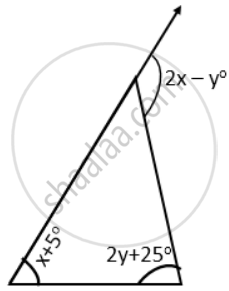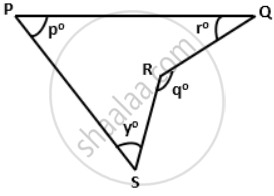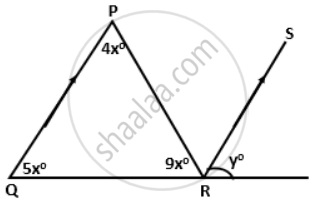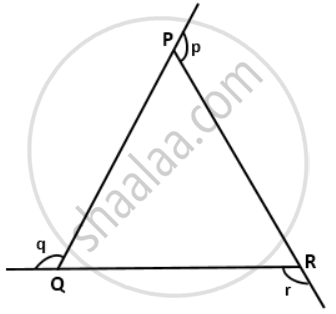Advertisements
Advertisements
Question
In a triangle PQR, ∠P + ∠Q = 130° and ∠P + ∠R = 120°. Calculate each angle of the triangle.
Solution

In ΔPQR,
∠P + ∠Q = 130° ....(given)
Now, ∠P + ∠Q = ∠PRY ....(Exterior angle property)
⇒ ∠PRY = 130°
∠PRY + ∠R = 180° ....(Linear pair)
⇒ 130° + ∠R = 180°
⇒ ∠R = 180° - 130° = 50°
Also, ∠P + ∠R = 120° ....(given)
Now, ∠P + ∠R = ∠PQX ....(Exeterior angle property)
⇒ ∠PQx = 120°
∠PQX +∠Q = 180° ....(Linear pair)
⇒ 120°+ ∠Q = 180°
⇒ ∠Q = 180° - 120° = 60°
In ΔPQR,
∠P + ∠Q + ∠R = 180° ....(Angle sum property of a triangle)
⇒ ∠P + 60° + 50° = 180°
⇒ ∠P = 180° - 110° = 70°
Thus, the angles of ΔPQR are as follows:
∠P = 70°, ∠Q = 60° and ∠R = 50°.
APPEARS IN
RELATED QUESTIONS
The exterior angles, obtained on producing the side of a triangle both ways, are 100° and 120°. Find all the angles of the triangle.
Use the given figure to find the value of x in terms of y. Calculate x, if y = 15°.
The angles of a triangle are (x + 10)°, (x + 30)° and (x - 10)°. Find the value of 'x'. Also, find the measure of each angle of the triangle.
Use the given figure to find the value of y in terms of p, q and r.
In the figure given below, if RS is parallel to PQ, then find the value of ∠y.
Use the given figure to show that: ∠p + ∠q + ∠r = 360°.
In a triangle ABC, if the bisectors of angles ABC and ACB meet at M then prove that: ∠BMC = 90° + `(1)/(2)` ∠A.
If each angle of a triangle is less than the sum of the other two angles of it; prove that the triangle is acute-angled.
If the angles of a triangle are in the ratio 2: 4: 6; show that the triangle is a right-angled triangle.
In a right-angled triangle ABC, ∠B = 90°. If BA and BC produced to the points P and Q respectively, find the value of ∠PAC + ∠QCA.
